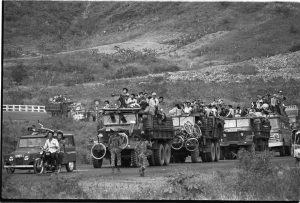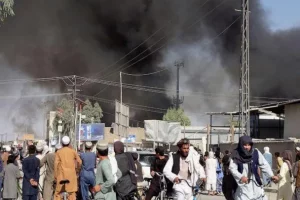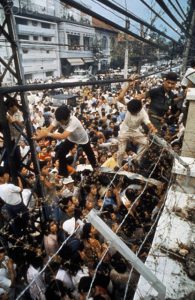America’s 20-year war in Afghanistan with an enemy and a people still stuck in the Middle Ages has ended.
Finally.
And just as it was 47 years ago in a place called Vietnam, it did not end in victory.
That became clear on Sunday when Taliban forces entered Kabul essentially unimpeded by a collapsing Afghan army. On the way, they released thousands of Al Qaeda and Taliban fighters from a prison on the outskirts of the capital.
Early on in the conflict, America’s military crushed Al Qaeda and neutralized the Taliban. But for the past ten years or so, the war was little more than a holding action against an enemy that worked assiduously to consolidate its power via a loose alliance of warlords and their private armies.
As they did, the Taliban kept gaining more and more territory until by early this year, it controlled almost four-fifths of the country’s landmass.
Fighting the Taliban, like fighting the Viet Cong in Vietnam, was like trying to kill a cobra by hacking at its tail. American and coalition forces could never cut off the head of the snake because there really wasn’t one–or if there was, they never found it.
In April 1975, I watched the communist North Vietnamese Army move inexorably south from Hue, Da Nang, Nha Trang, and Cam Ranh Bay until they were on the outskirts of Bien Hoa, just 25 miles from Saigon.
Under terms of the 1973 Paris Peace Accords, North Vietnamese troops were not supposed to be south of the 17th parallel.
But they were, and they were moving fast.
The U.S. Congress ignored pleas for help by the South Vietnamese government and America’s ambassador in Saigon. For those who may have forgotten, in April 1975, then-U.S. Sen. Joe Biden argued against $1 billion in emergency aid for South Vietnam, insisting that the South Vietnamese military might use the money.
Today, Biden is president, and his actions vis-à-vis Afghanistan are receiving fitting criticism—especially for what appears to be a mounting humanitarian crisis.
Some 400,000 Afghani civilians have been forced from their homes since the start of the year, 250,000 of them since May. Families are camping out in a Kabul park with little or no shelter, having escaped violence elsewhere in the country. In all, some 2.9 million Afghan civilians have been displaced since the war began in 2001.
Taliban forces now control all of Afghanistan in the wake of America’s decision to withdraw. Thousands of Afghan soldiers in what Biden bragged a couple of months ago was a “well-equipped and trained” Afghan army of 300,000, were seen frantically discarding their uniforms and weapons and running for safety as Taliban forces entered Kabul.
I watched soldiers in the South Vietnamese army do the same thing 47 years ago as the NVA entered Saigon.
Was it a disgusting display of rank cowardice? Possibly. But it was also thousands of soldiers recognizing the fact that the war for the hearts and minds of the South Vietnamese people was lost. The communist north had won. Why die for a lost cause?
The situation in Afghanistan is hauntingly similar.
“The situation has all the hallmarks of a humanitarian catastrophe,” an official with the U.N. World Food Program’s told reporters.

During the fall of South Vietnam, I witnessed tens of thousands of terrified South Vietnamese driven from their homes by violence and war move south along Highway One—some in over-loaded trucks crammed with people and whatever belongings they could carry.
Fifty or 60 miles behind them, the North Vietnamese Army trailed them with tanks and trucks.
Today, we are seeing a replay of that event in Afghanistan.
In response, the State Department reduced its staff in the U. S. Embassy in Kabul and has instructed all U.S. personnel to destroy items like documents and electronic devices to “reduce the amount of sensitive material on the property,” according to an internal notice obtained by reporters.
“Please also include items with embassy or agency logos, Americans flags, or items which could be misused in propaganda efforts,” the notice said.
Forty-seven years ago, the same thing happened in the American Embassy in Saigon. Shredding machines were working overtime, bonfires were burning sensitive material inside the vast embassy compound, and embassy staff was being flown out of Tan Son Nhut airport secretly a few at a time.
South Vietnamese who had worked for and with the U.S. military in Vietnam watched in horror as their country fell apart day after day between March and April 1975. Many began fleeing the country a few weeks before the North Vietnamese entered the city—terrified that their cooperation with the Americans would mean certain death.
For many who were left behind during the chaotic evacuation of Saigon, those fears were realized—if not immediately after the NVA entered the city, then months and even years later when they were thrown into communist concentration camps euphemistically referred to as “reeducation camps.”
As events unfold in Afghanistan, I wonder what will happen to the thousands of Afghanis who worked for Americans and their coalition partners. Hundreds of not thousands of Afghanis loyal to the United States and other coalition nations will likely be slaughtered by a ruthless and vengeful Taliban.
The Biden administration says it is prepared to begin evacuation flights for Afghan interpreters and translators who aided the U.S. military effort in the 20-year war — but their destinations are still unknown.
Now, with the Taliban inside of Kabul, there are troubling questions about how to ensure their safety until they can get on planes–if they ever do.
Poor evacuation planning by the Biden administration could potentially affect tens of thousands of Afghans. Several thousand Afghans who worked for the United States — plus their family members — are already in the application pipeline for special immigrant visas. But now that the Taliban are in Kabul and possibly surrounding the U.S. Embassy, you have to wonder how the evacuation apparatus will function.

“What this is not — this is not abandonment. This is not an evacuation. This is not the wholesale withdrawal,” State Department spokesman Ned Price insisted Thursday.
It isn’t? It certainly looks that way. And what about those vulnerable 18,000 or so Afghanis who risked their lives working for American and coalition forces as interpreters, drivers, and fixers, etc.?
There are still too many unanswered questions—just as there were in Saigon in 1975. Almost every day leading up to the final evacuation, I was confronted by anguished and panicked Vietnamese worried about how they could get on an evacuation flight before the communist takeover.
How many people are eligible for evacuation in Afghanistan? How will those outside the capital reach safety to be evacuated? To what countries will they be evacuated?
And what of Afghan President Ashraf Ghani?
Not to worry about him. He fled the country Saturday rather than face what might have been certain death at the hands of the Taliban and their Al Qaeda brothers.
So, is Afghanistan 2021 a repeat of South Vietnam 1975?

Clearly, these are entirely different countries with entirely different issues. The NVA was a highly mechanized, disciplined, and unified professional army. The Taliban is a loose conglomeration of warlords and disparate Afghani tribes, whose members have long memories and who have sworn vengeance against their enemies.
But there are also similarities, and probably the most troubling for me, is what happens to those Afghanis who put their lives and futures on the line by working for Americans?
I know what happened to tens of thousands of Vietnamese who were left behind when U.S. Marine helicopters ferried 1,373 Americans and 5,680 Vietnamese to safety from a chaotic and frenzied Saigon between April 29 and April 30, 1975.
They were abandoned, executed, imprisoned, tortured, and forgotten.
Will things be different in Afghanistan?


Thank you, Ron, for this poignant reminder to pray for those who are navigating dire straits.
I just hope we don’t make the same mistakes in Afghanistan that we did during the chaos in Saigon.
We will. I’ve seen this show too many times. Pray.